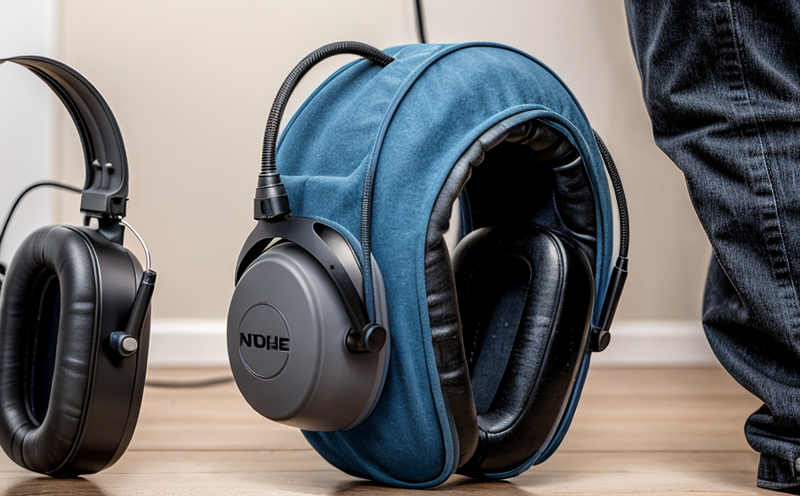EN ISO 4869-2 Noise Reduction Rating Testing
The EN ISO 4869 series of standards is internationally recognized for providing a comprehensive framework for the testing and assessment of hearing protection devices (HPDs) used in occupational safety environments. The specific focus here is on EN ISO 4869-2 Noise Reduction Rating Testing. This standard establishes methods to determine the Noise Reduction Rating (NRR) of HPDs, which quantifies the sound attenuation provided by these protective equipment.
The testing procedure outlined in EN ISO 4869-2 is critical for ensuring that hearing protection devices meet the required safety and performance criteria. The NRR test measures the reduction in noise level achieved when a person wears the HPD, as compared to when they do not. This measurement helps employers make informed decisions about selecting appropriate protective equipment that effectively reduces hazardous noise levels.
The testing process involves several key steps:
- Preparation of Test Specimens: HPDs are prepared in accordance with the specifications detailed in EN ISO 4869-2. This includes ensuring that all devices conform to the correct size and shape, as well as being properly fitted.
- Noise Generation: A sound source generates broadband noise within a specific frequency range over which the HPD is expected to provide protection. The sound level is carefully controlled to simulate real-world scenarios.
- Measurement of Noise Attenuation: Using specialized measurement equipment, the noise reduction provided by the HPD is measured. This involves comparing the noise levels before and after the use of the protective device.
The results are expressed as a single number representing the NRR value for the specific HPD being tested. It's important to note that while this test provides valuable data, it is not a guarantee of protection in all situations. Factors such as fit and user compliance can significantly impact the actual noise reduction achieved.
The importance of accurate testing cannot be overstated. In industries like manufacturing, construction, mining, and transportation, where high levels of background noise are common, ensuring that workers have adequate hearing protection is paramount for maintaining occupational safety standards. By adhering to EN ISO 4869-2, laboratories can provide reliable data that helps employers make informed decisions about the HPDs they choose to use.
Understanding the parameters involved in this testing method can also assist R&D engineers and quality managers in optimizing their designs. For instance, knowing how different materials or configurations affect noise reduction allows for iterative improvements. Similarly, compliance officers rely on these tests to ensure that all products meet regulatory requirements, thus protecting workers from potential hearing loss.
In summary, EN ISO 4869-2 Noise Reduction Rating Testing is an essential part of ensuring the safety and effectiveness of hearing protection devices in occupational environments. By following this rigorous testing protocol, laboratories can provide accurate data that informs critical decisions about protective equipment selection and usage.
Applied Standards
The primary standard applied for noise reduction rating testing is EN ISO 4869-2. This standard specifies the methods for determining the Noise Reduction Rating (NRR) of hearing protection devices by measuring their sound attenuation performance in a controlled laboratory environment.
EN ISO 4869:2013 covers various aspects related to HPDs, including:
- Determination of the Noise Reduction Rating (NRR) using the specified test methods.
- Characterization and classification of hearing protectors based on their noise reduction capabilities.
- Requirements for test laboratories conducting such evaluations to ensure accuracy and repeatability.
The standard also references additional standards like ISO 1994, which provides guidance on the measurement of sound pressure levels. By aligning with these international standards, laboratories can ensure that their testing methodologies are consistent with global best practices, thereby enhancing the credibility and reliability of their results.
Scope and Methodology
The scope of EN ISO 4869-2 Noise Reduction Rating Testing is to provide a standardized method for determining the effectiveness of hearing protection devices in reducing noise exposure. This testing ensures that HPDs meet stringent performance criteria, which are crucial for safeguarding workers' hearing health.
The methodology involves several critical steps:
- Selecting Test Specimens: A representative sample of the hearing protection devices is selected based on its intended use and design parameters. This ensures that the test results are relevant to real-world applications.
- Setting Up Test Conditions: The laboratory environment is calibrated to simulate typical workplace noise conditions, including frequency ranges and sound pressure levels pertinent to the device being tested.
- Performing Attenuation Measurements: Using precision equipment, the attenuation provided by the HPD is measured. This involves placing a test subject with the hearing protection in place and measuring the difference between ambient noise and noise perceived when wearing the device.
The methodology also includes detailed procedures for handling results, including statistical analysis to ensure accuracy and consistency. Compliance with these stringent protocols guarantees that the NRR values reported are reliable indicators of real-world performance.
Benefits
The benefits of adhering to EN ISO 4869-2 Noise Reduction Rating Testing extend across multiple stakeholders in the occupational safety sector:
- Enhanced Worker Safety: Accurate and reliable NRR testing ensures that workers are provided with hearing protection devices that effectively reduce noise exposure, thereby minimizing the risk of permanent hearing damage.
- Regulatory Compliance: By meeting international standards like EN ISO 4869-2, employers demonstrate their commitment to compliance with occupational health and safety regulations, which can help avoid legal penalties and improve company reputation.
- R&D Advancement: For manufacturers of hearing protection devices, following these testing protocols allows for continuous improvement in product design and performance. This leads to the development of more effective and user-friendly HPDs.
- Cost Efficiency: Ensuring that workers have appropriate protective equipment reduces the likelihood of workplace injuries and associated costs such as medical expenses and lost productivity due to disability or absenteeism.
In summary, implementing EN ISO 4869-2 Noise Reduction Rating Testing provides tangible benefits for all parties involved in occupational safety. It fosters a safer work environment while supporting regulatory compliance and fostering innovation within the industry.





